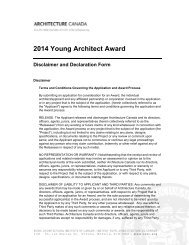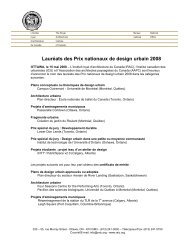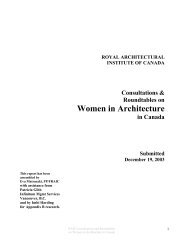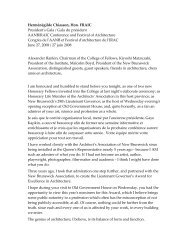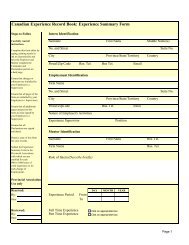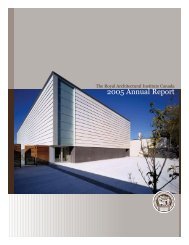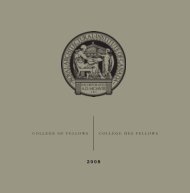Benchmark Study on Green Buildings - Royal Architectural Institute ...
Benchmark Study on Green Buildings - Royal Architectural Institute ...
Benchmark Study on Green Buildings - Royal Architectural Institute ...
You also want an ePaper? Increase the reach of your titles
YUMPU automatically turns print PDFs into web optimized ePapers that Google loves.
The Japan <strong>Green</strong> Building Council (JGBC) (www.jgbc.com/) was founded in 1998 with<br />
83 members. The JGBC, with 126 members to date, is currently more of a service-based<br />
green building council compared to others such as the USGBC. It offers free services,<br />
such as energy audits and surveys measuring surface temperature, whether wood is<br />
properly engineered or not, water use and treatment, and lighting efficiency. The goal is<br />
to gather data in order to prove the validity of JGBC with this informati<strong>on</strong> in hand. The<br />
JGBC is also a member of the World <strong>Green</strong> Building Council (WGBC).<br />
The Japanese green building movement is younger than initiatives in many other<br />
countries and Japanese architects c<strong>on</strong>tinue to lack c<strong>on</strong>siderable interest in green building.<br />
Currently architects design for ecological resistance or modern attractiveness, but these<br />
styles are also changing to incorporate more green practices and procedures. To date, the<br />
JGBC does not have a rating system for green buildings. Additi<strong>on</strong>ally, the Japanese<br />
government is helping to increase green building awareness as it demands that new<br />
buildings be green and that older buildings be greened. Japanese materials manufacturers<br />
are also beginning to make green products, but this c<strong>on</strong>tinues to be at a relatively low<br />
level. Cost-competiti<strong>on</strong> is very important am<strong>on</strong>g Japanese buyers because it is usually<br />
more expensive to obtain products from abroad. About a quarter of the companies<br />
registered under the JGBC are based outside of Japan, and want to sell their products to<br />
the growing Japanese green building market. So, while the main goals of the JGBC<br />
include the promoti<strong>on</strong> of green building awareness and the provisi<strong>on</strong> of greening services,<br />
encouraging Japanese manufacturers to create more green products is also a large c<strong>on</strong>cern.<br />
The aim of the JGBC is to reduce the envir<strong>on</strong>mental impact of the nati<strong>on</strong>’s buildings<br />
through improvements in planning, c<strong>on</strong>structi<strong>on</strong> and waste disposal. Certified as a<br />
nati<strong>on</strong>al n<strong>on</strong>profit organizati<strong>on</strong> in 2003, its website already receives over 1,000 hits per<br />
m<strong>on</strong>th and membership is steadily increasing.<br />
Apart from its building auditing and surveying services, the JGBC has not yet started<br />
many other green building projects or procedures. Apart from a handful nati<strong>on</strong>al green<br />
building seminars, the JGBC has so far played the role of a participant in initiatives put<br />
forward by other countries. Such initiatives include the 1999 <strong>Green</strong> Building Tour in the<br />
United States and various World-GBC meetings. But for a country that looks to gradually<br />
build up its own green building council, participating in initiatives started by other<br />
leading countries and learning from them is certainly an effective approach that will make<br />
the JGBC a leader in the near future.<br />
There is also another large green building organizati<strong>on</strong> in Japan. The Japan Sustainable<br />
Building C<strong>on</strong>sortium (JSBC) was established in April 2001 as a joint framework between<br />
industry, government and academia, under the auspice of the Japanese Ministry of Land,<br />
Infrastructure and Transport. The research activities of the JSBC have already provided<br />
numerous positive outcomes, the most important being the Comprehensive Assessment<br />
System for Building Envir<strong>on</strong>mental Efficiency (CASBEE). CASBEE is designed to<br />
evaluate the envir<strong>on</strong>mental performance of buildings – similar to how the LEED and<br />
BREEAM (Building Research Establishment Envir<strong>on</strong>mental Assessment Method)<br />
systems functi<strong>on</strong>. The intent is for CASBEE (al<strong>on</strong>g with LEED and BREEAM in their<br />
38



